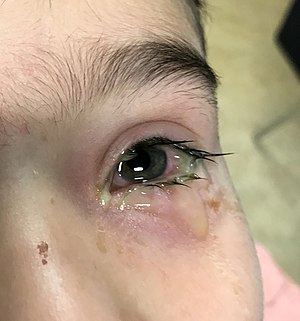Bacterial conjunctivitis
Unilateral inflammation with mucous secretions occurs most often in winter and spring. The clinical picture develops within hours. Conjunctival superficial injection and eyelid edema are other symptoms. Within 1-2 days, the other eye usually succumbs to inflammation. Bacterial conjunctivitis accounts for about 5% of all conjunctivitis.
Hyperacute bacterial conjunctivitis[edit | edit source]
The infection is caused by Neisseria gonorrhoeae and Neisseria meningitidis. In the first case, it is mainly sexual transmission through direct contact (see neonatal conjunctivitis), or as autoinfection of adults. The time window is only a few hours after the infection. We clinically describe painful to planar eyelid edema, chemosis, conjunctival injection and dense purulent secretion accompanied by swollen preauricular nodes. The untreated infection progresses from keratitis to corneal ulcers. Microscopic diagnosis confirms Gram-negative diplococci stained according to Gram on swab and agar culture.
Therapy[edit | edit source]
Local and systemic antibiotics. Crystalline G penicillin i.m. 5-7 days at a dose of 100,000 IU / kg / day. Locally G penicillin 100,000 U / ml solid day after one hour, the next day after 2 hours and then 5 drops daily in both eyes 5 times a day. For beta-lactam allergy, we choose 2nd and 3rd generation cephalosporins.
Acute bacterial conjunctivitis[edit | edit source]
The most common pathogens are Streptococcus pneumoniae and Streptococcus pyogenes, Haemophilus influenzae, Staphylococcus aureus and Moraxella lacunata. Clinically, we describe conjunctival injection, tearing and slimy secretion, which glues the eyelids. The other eye is usually affected within 1-2 days. Streptococcus pneumoniae infection is accompanied by swelling of the eyelids, conjunctival hemorrhage, and the formation of membranes on the tarsal conjunctiva. Hemophilic infections, on the other hand, can lead to corneal complications (infiltrates, ulcers). In children, inflammation is usually accompanied by an alteration of the general condition. It disappears in 10-14 days.
Therapy[edit | edit source]
Iodine rinsing (Betadine) with a dilution of 1:16, broad-spectrum antibiotics every 2–4 hours topically in drops or as an ointment with a duration of use of 7–10 days. Systemic antibiotic treatment is only necessary for chronic bacterial conjunctivitis.
Chronic bacterial conjunctivitis[edit | edit source]
Chronic bacterial conjunctivitis usually has a long, not dramatic course. The most common pathogens are S. aureus and Moraxella sp. Less often, they can typically be intestinal bacteria of the genus Proteus, E. coli, Klebsiella pneumoniae and others. The accompanying manifestation is inflammation of the eyelids.
Trachoma is a rare complication in the Czech Republic, however, is still the most common treatable cause of blindness in the world.
Links[edit | edit source]
Literature[edit | edit source]
- ROZSÍVAL, Pavel, et al. Oční lékařství. 1. vydání. Praha : Galén, 2006. 373 s. ISBN 80-7262-404-0.
- HYCL, Josef a Lucie VALEŠOVÁ. Atlas oftalmologie. 1. vydání. Praha : Triton, 2003. ISBN 80-7254-382-2.



